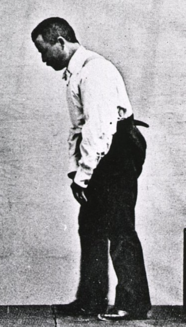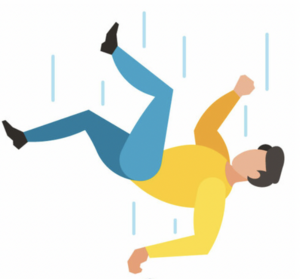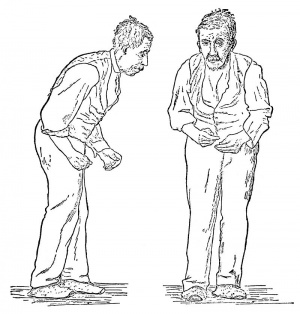Postural Instability
Original Editor - Lucinda hampton
Top Contributors - Ayodeji Mark-Adewunmi and Lucinda hampton
Introduction[edit | edit source]
Postural instability (PI) is the inability able to maintain equilibrium under dynamic and static conditions, for example preparation of movements, perturbations, and quiet stance.
Postural instability is seen in a diverse group of conditions, most notably parkinson's and extrapyramidal diseases (eg parkinsonism, chorea, athetosis).[1] [2]
Postural instability often leads to falls, often requiring medical assistance[3].
Testing Postural Instability[edit | edit source]
The Retropulsion Test is the gold standard to evaluate postural instability. The test involves a rapid balance perturbation in the backward direction. The number of balance correcting steps (or total absence of) is used to rate the degree of postural instability. Taking three or more steps is generally considered to be abnormal, and taking more than five steps is regarded as being clearly abnormal.
Response to backward perturbation
- Healthy subjects correct such perturbations with either one or two large steps, or without taking any steps, hinging rapidly at the hips while swinging the arms forward as a counterweight.
- Patients with postural instability, balance correcting steps are often too small, patients then need to take more than two steps.
- Noticeably affected patients continue to step backward never regaining their balance and must be caught by the examiner.
- Most markedly affected patients fail to correct, and fall backward like a dummy, without taking any corrective steps.[4]
Physiotherapy[edit | edit source]
Physiotherapy interventions are effective in improving balance in patients, when used in combination, not as a stand alone intervention. A combination of the below proves effective.
- Balance training (highly challenging balance training should be included)
- Muscle strengthening
- Range of movement exercises
- Gait training (incremental speed-dependent treadmill training if appropriate)[5]See Gait Re-education in Parkinson's
See Parkinson's - Physiotherapy Management and Interventions
References[edit | edit source]
- ↑ Medical Dictionary Extrapyramidal Syndrome Available:https://medical-dictionary.thefreedictionary.com/extrapyramidal+syndrome (accessed 4.11.2022)
- ↑ Djaldetti R, Lorberboym M, Melamed E. Primary postural instability: a cause of recurrent sudden falls in the elderly. Neurological sciences. 2006 Dec;27(6):412-6. Available:https://pubmed.ncbi.nlm.nih.gov/17205226/ (accessed 4.11.2022)
- ↑ Appeadu M, Gupta V. Postural Instability. 2020 Available:https://www.ncbi.nlm.nih.gov/books/NBK560906/ (accessed 4.11.2022)
- ↑ NIH Postural Instability Available:https://www.ncbi.nlm.nih.gov/medgen/334529 (accessed 4.11.2022)
- ↑ Yitayeh A, Teshome A. The effectiveness of physiotherapy treatment on balance dysfunction and postural instability in persons with Parkinson’s disease: a systematic review and meta-analysis. BMC sports science, medicine and rehabilitation. 2016 Dec;8(1):1-0. Available:https://bmcsportsscimedrehabil.biomedcentral.com/articles/10.1186/s13102-016-0042-0 (accessed 4.11.2022)









